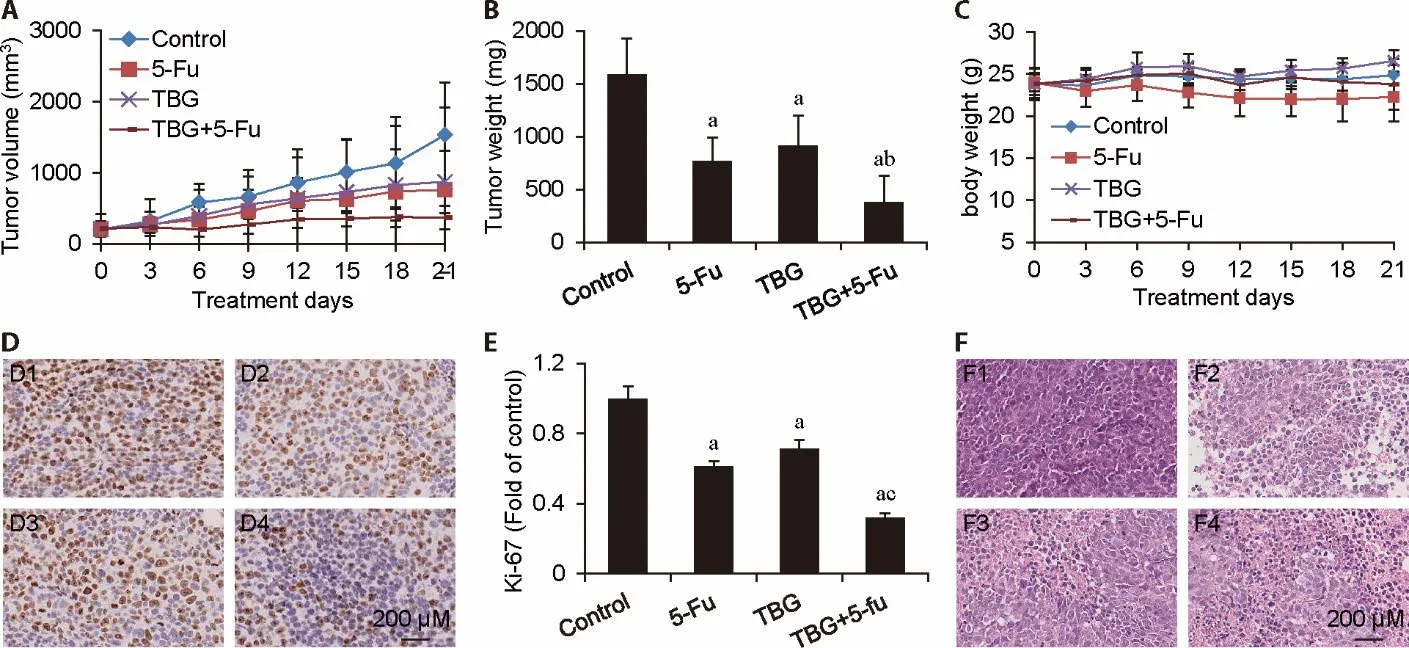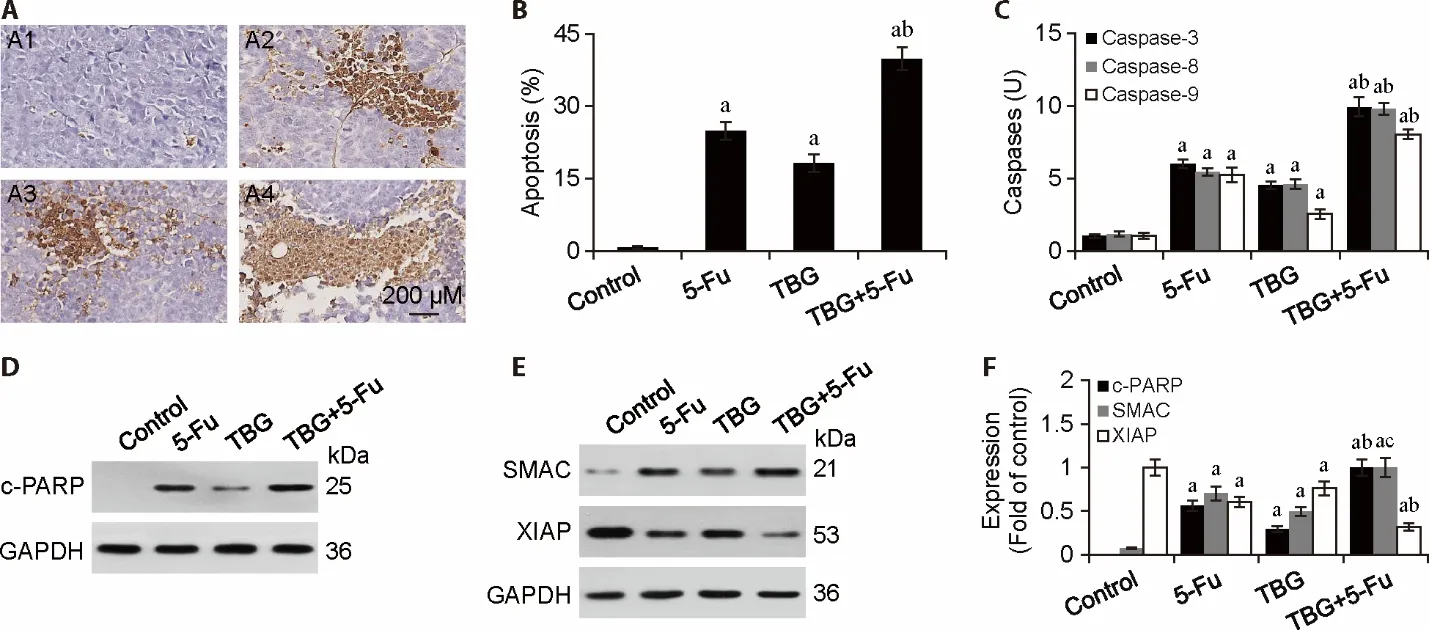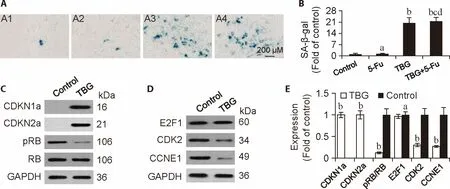Tenglong Buzhong granules (藤龙补中颗粒) inhibits the growth of SW620 human colon cancer in vivo
2022-10-14LIMiaoZHENGJialuWANGShuangshuangCHENLeiPENGXiaoCHENJinfangANHongmeiHUBing
LI Miao,ZHENG Jialu,WANG Shuangshuang,CHEN Lei,PENG Xiao,CHEN Jinfang,AN Hongmei,HU Bing
LI Miao,CHEN Lei,PENG Xiao,CHEN Jinfang,HU Bing,Institute of Traditional Chinese Medicine in Oncology,Longhua Hospital,Shanghai University of Traditional Chinese Medicine,Shanghai 200032,China
LI Miao,ZHENG JiaLu,CHEN Lei,PENG Xiao,CHEN Jinfang,HU Bing,Department of Oncology,Longhua Hospital,Shanghai University of Traditional Chinese Medicine,Shanghai 200032,China
WANG Shuangshuang,Shanghai University of Traditional Chinese Medicine,Shanghai 201203,China
AN Hongmei,Department of Science and Technology,Longhua Hospital,Shanghai University of Traditional Chinese Medicine,Shanghai 200032,China
Abstract OBJECTIVE: To observe the anticancer effects of the granular preparation of Tenglong Buzhong decoction (藤龙补中汤,TBD),i.e Tenglong Buzhong granules (藤龙补中颗粒,TBG),in human SW620 colon cancer.METHODS: BALB/c nude mice were subcutaneously transplanted with SW620 cells,and treated with TBG(2.56 g/kg,once per day) and/or 5-Fu (104 mg/kg,once per week) for 21 d.Apoptosis,Caspase activities and cellular senescence were measured by commercial kits.The protein expression and phosphorylation were detected by Western blot or immunohistochemistry.RESULTS: TBG and 5-Fu inhibited tumor growth.The tumor inhibition rate of the TBG,5-Fu,and TBG+5-Fu groups was 42.25%,51.58%,and 76.08%,respectively.Combination of TBG and 5-Fu showed synergetic anticancer effects.TBG and 5-Fu induced apoptosis,activated caspase-3,-8,and -9,increased SMACexpression,inhibited XIAP expression.TBG induced cellular senescence,upregulated cyclin-dependent kinase inhibitor 1a (CDKN1a) and cyclin-dependent kinase inhibitor 2a (CDKN2a) expression,and inhibited phosphorylation of retinoblastoma-associated protein(RB) and expression of cyclin E1 (CCNE1) and cyclindependent kinases (CDK) 2.TBG also inhibited angiogenesis accompanied by downregulation of vascular endothelial growth factor (VEGF) and hypoxiainducible factor-1α (HIF-1α).CONCLUSIONS: TBG inhibits SW620 colon cancer growth,induces apoptosis via SMAC-XIAP-Caspases signaling,induces cellular senescence through CDKN1a/CDKN2a-RB-E2F signaling,inhibits angiogenesis by down-regulation of HIF-1α and VEGF,and enhances the effects of 5-Fu.
Keywords: colonic neoplasms;apoptosis;cellular senescence;signal transduction;angiogenesis;Tenglong Buzhong granules
1.INTRODUCTION
Colorectal carcinoma (CRC) is a common malignant tumor worldwide that ranks third in morbidity and second in mortality.1Surgery,chemotherapy,and targeted therapy are the leading methods to treat CRC.2,3Traditional Chinese medicine (TCM) has been widely used in all aspects of the comprehensive treatment of CRC.4,5Herb decoction and patent Chinese medicine are the major types of TCM to treat CRC.Patent Chinese medicine,such as Kanglaite injection,Yadanzi (Fructus Bruceae Javanicae) preparations (capsules and injection),and Aidi injection,have showed clinical benefits for CRC,such as increasing tumor response,improving quality of life,ameliorating myelosuppression,and enhancing immunity.5-7
Decoction is another type of TCM treatment for CRC.We have developed a herbal formula,Tenglong Buzhong decoction (藤龙补中汤,TBD),based on the therapeutic methods of Jiedu (detoxifying),Lishi (draining dampness),and Jianpi (tonifying spleen).TBD is composed of several anti-cancer herbs.Mihoutaogen(Radix Actinidiae Chinensis) inhibits cell proliferation and metastasis in different tumors.8,9Longkui (Herba Solani Nigri) and its components inhibit the proliferation of tumor cells,induce apoptosis,and inhibit metastasis.10,11Banzhilian (Herba Scutellariae Barbatae)induces apoptosis and inhibits the growth and metastasis of CRC.12,13Yiyiren (Semen Coicis) is a raw material of the Chinese patent medicine Kanglaite injection and can be used to treat cancers.14
As a decoction,TBD inhibits the growth of metastatic CRC tumors,reduces the toxic and side effects of chemotherapy,alleviates the symptoms,improves the life quality,and elicits Th1 immune response in patients with CRC.15,16TBD inhibits cell proliferation,induces apoptosis,cell cycle arrest and cellular senescence in CRC cells.17,18Based on the composition of TBD,we further developed the granular preparation of TBD(Tenglong Buzhong granules,藤龙补中颗粒,TBG).19In the present study,we observed the effect of TBG on SW620 human colon cancer growth and elucidated the potential mechanisms in the nude mice xenograft tumor model.
2.MATERIALS AND METHODS
2.1.Chemicals and reagents
L-15 medium,fetal bovine serum (FBS),and trypsin were obtained from Gibco (Grand Island,NY,USA).5-Fluorouracil (5-Fu) was purchased from Xudong Haipu Pharmaceutical (Shanghai,China).Bradford protein assay kit and Caspases activity assay kit was procured from Beyotime (Haimen,China).Senescence-associated β-galactosidase (SA-β-Gal) staining kit was purchased from BestBio (Shanghai,China).Terminal deoxynucleotidyl transferase (TdT)-mediated dUTP nick end labeling (TUNEL) kit was obtained from Promega(Madison,WI,USA).Antibodies against glyceroldehyde-3-phosphate dehydrogenase (GAPDH),cyclindependent kinase inhibitor 1a (CDKN1a),cyclindependent kinase inhibitor 2a (CDKN2a),retinoblastoma-associated protein (RB),phosphorylated RB (p-RB),cyclin E1 (CCNE1),cyclin-dependent kinases(CDK) 2 were purchased from Bioworld (St.Louis Park,MN,USA).Vascular endothelial growth factor (VEGF),cleaved poly ADP-ribose polymerase (cPARP),hypoxiainducible factor-1α (HIF-1α),second mitochondriaderived activator of caspases (SMAC),X-linked inhibitor of apoptosis protein (XIAP),Ki67 and CD31 antibodies were purchased from Abcam (Cambridge,MA,USA).TBG (Lot No.20171101) were prepared by the School of TCM,Shanghai University of TCM(Shanghai,China) as described previously.19
2.2.Cell culture
Human colon cancer SW620 cells were obtained from the Cell Bank of Type Culture Collection of the Chinese Academy of Sciences and cultured in L-15 medium (10%FBS and 1% penicillin-streptomycin) at 37 °C in a humidified incubator with 5% CO2atmosphere.Cells in the logarithmic phase were used for an animal experiment.
2.3.Animal model and treatment
Six-week-old male BALB/c nude mice were purchased from Shanghai SLAC Laboratory Animal Center and housed in the SPF animal laboratory.Mice were subcutaneously inoculated with 1×106SW620 cells.After the tumors grew to a measurable range (about 200 mm3),the mice were randomly divided into four groups (n=10) according to the tumor size by randomized digital table,administered 0.2 mL sterile water or TBG (2.56 g granules/kg) intragastrically,once per day,and/or were intraperitoneally injected with 5-Fu (104 mg/kg,0.2 mL) once per week;the treatment lasted three weeks.The greatest longitudinal diameter (length) and the greatest transverse diameter(width) were measured by caliper every three days.The tumor volume was calculated by the formula: Volume=π/6 × length × width2.Upon completion of the treatment,the tumors were stripped,weighed,and fixed with 4%paraformaldehyde or stored at-80 °C.All procedures and experiments involving mice were approved by the Longhua Hospital Animal Care and Use Committee.
2.4.TUNEL assay
Cell apoptosis was detected by the TUNEL assay,according to the manufacturer’s manual.Briefly,the tumor tissues were embedded in paraffin and sectioned,dewaxed,dehydrated,and incubated with proteinase K at room temperature (RT) for 20 min.Then,the tissues were washed with phosphate-buffered saline (PBS) and incubated in TdT reaction mixture at RT for 30 min.The reaction was terminated with 2× SSC buffer solution,washed with PBS,incubated with streptavidin-HRP at RT for 30 min,stained with DAB,counterstained with hematoxylin,and sealed with resin.The sections were observed and photographed under a microscope and analysed by Image-Pro Plus 6.0 software (Media Cybernetics,Silver Spring,MD,USA).
2.5.Detection of the activities of Caspases
The activity of Caspases was detected according to the manufacturer’s protocol.Briefly,the tumor tissues were lysed and the supernatant were collected and quantified.Ac-DEVD-pNA,Ac-IETD-pNA,and Ac-LEHD-pNA were used as the substrates for the protein samples,the content of the cleaved product pNA was detected,and the activity of Caspase-3,-8,and -9 was calculated.
2.6.SA-β-Gal staining
Cellular senescence was detected according to the kit specifications.Briefly,the tumor tissues were frozen,sectioned,and fixed in 2% formaldehyde and 2%glutaraldehyde at room temperature for 10 min.Then,the sections were washed with PBS and stained with X-gal solution overnight at 37 °C.The Image-Pro Plus 6.0 software (Media Cybernetics,Silver Spring,MD,USA)was used to quantify the blue-stained cells.
2.7.Immunohistochemistry (IHC)
The tumor tissues were embedded in paraffin and sectioned into 5-μm-thick slices that were dewaxed and dehydrated.The sections were incubated in 3% H2O2at RT for 15 min,blocked with 5% normal goat serum,incubated with Ki-67 and CD31 antibodies (1:100) at 4 °C overnight,washed with PBS,incubated with secondary antibodies for 30 min,stained with DAB,counterstained with hematoxylin,and sealed with resin.The sections were observed,photographed under a microscope and analysed by The Image-Pro Plus 6.0 software (Media Cybernetics,Silver Spring,MD,USA).
2.8.Western blot
The tumor tissues were lysed,quantified,and denatured.Proteins were separated by 8%–10% sodium dodecyl sulfate-polyacrylamide gel electrophoresis and transferred to polyvinylidene fluoride membranes.The membranes were blocked with 5% non-fat milk and probed with cPARP (1:2000),SMAC (1:1000),XIAP(1:1000),CDKN2a (1:700),CDKN1a (1:1000),RB(1:1000),p-RB (1:1000),E2F1 (1:2000),CCNE1(1:1000),CDK2 (1:1000),VEGF (1:1000),HIF-1α(1:1000),or GAPDH (1:2000) antibodies at 4 °C overnight.Then,the blots were washed with PBST,incubated with horseradish peroxidase conjugated secondary antibodies (1:5000) at RT for 2 h,developed with enhanced chemiluminescence substrate,and quantified by Quantity One software (Bio-Rad,Hercules,CA,USA).
2.9.Statistical analyses
The data are expressed as mean ± standard deviation (± s).One-way analysis of variance was employed to compare differences between groups by using IBM SPSS Statistics for Windows,Version 21.0.(IBM Corp.,Armonk,NY,USA).P <0.05 indicated a statistically significant difference.
3.RESULTS
3.1.TBG inhibited tumor growth
We first observed the effect of TBG on tumor growth.The results showed that the tumors in the control group proliferated continuously and 5-Fu and TBG inhibited tumor growth,and significant differences were detected in the tumor volume and weight compared to the control group (P< 0.05).TBG enhances the inhibitory effect of 5-Fu on tumor growth (P< 0.05) (Figure 1A,1B).The tumor inhibition rate of the TBG,5-Fu,and TBG+5-Fu groups was 42.25%,51.58%,and 76.08%,respectively.The combination index (CI) (Bliss independence model)20of TBG and 5-Fu was 0.95,indicating a synergistic effect.We also observed potential toxic effects of TBG.As shown in Figure 1C,the body weight of 5-Fu group was reduced slightly (P >0.05).Also,TBG slightly increased body weight (P >0.05),but had no significant effects on fur ruffling or changes in behavior and feeding in TBG and combination groups (data not shown).
3.2.TBG inhibited cell proliferation
The effect of TBG on cell proliferation was observed using Ki-67 as the marker protein.As shown in Figure 1D and 1E,Ki-67 expression in the tumor tissues of the control group was strongly positive,5-Fu and TBG inhibited Ki-67 expression (P <0.01),and TBG enhanced the effect of 5-Fu on Ki-67 (P <0.01),indicating that the combination of TBG and 5-Fu inhibit the proliferation of SW620 cells.We also examined the pathological change under microscope.As shown in Figure 1F,the cells were evenly distributed in control group,5-Fu treatment resulted necrosis and vacuole,while in TBG and combination groups,also showed necrosis and exhibited larger cell morphology.

Figure 1 Effects of TBG on tumor growth
3.3.TBG induced apoptosis
Apoptosis is a crucial mechanism for the treatment of tumors with drugs.21Herein,we detected the effect of TBG on apoptosis using the TUNEL method.The results showed that TBG and 5-Fu induced cell apoptosis (P <0.01),and TBG enhances the effect of 5-Fu on apoptosis(P <0.01) (Figure 2A,2B).
3.4.Effects of TBG on apoptosis regulatory proteins
Apoptosis is a caspases-mediated cascade and regulated by proteins,such as SMAC and XIAP.21,22As shown in Figure 2C-F,5-Fu and TBG activated Caspase-3,-8,and-9 (P <0.01),promoted the cleavage of PARP,the substrate of Caspase-3 (P <0.01),upregulated SMAC expression,and inhibited XIAP expression (P <0.01).The combined effect of TBG and 5-Fu was stronger than either treatment alone (P <0.01).
3.5.TBG induced cellular senescence
Cellular senescence is a major anticancer mechanism and a stable state in which cells irreversibly withdraw from the cell cycle and lose proliferation ability.23,24SA-β-Gal staining is a classical detection method for cellular senescence.25The results showed that 5-Fu did not significantly affect cellular senescence (P >0.05)(Figure 3).After treatment,SA-β-Gal staining was positive in the tumor tissues from TBG and combination groups (P <0.01) (Figure 3A,3B),but there were no statistically difference between those two groups (P >0.05),suggesting that TBG induces the senescence of SW620 cells.
3.6.The effects of TBG on cellular senescence-related proteins
Cellular senescence is regulated by CDKN1a/2a-RBE2F signal transduction.23,24The results showed that TBG upregulated the expression of CDKN1a and 2a and inhibited RB phosphorylation and the expression of E2F target genes CCNE1 and CDK2 (P <0.01);however,the expression of RB and E2F1 was not affected (Figure 3C,3D,3E).
3.7.TBG inhibited angiogenesis
Longkui (Herba Solani Nigri)and Banzhilian (Herba Scutellariae Barbatae)are two components of TBG that inhibit angiogenesis in various cancers.26,27Supposedly,TBG may inhibit angiogenesis in colon cancer.Hence,we detected angiogenesis by IHC using CD31 as a marker.The results showed that angiogenesis were significantly inhibited in TBG and combination groups(P <0.01),but there were no statistically difference between those two groups (P >0.05) (Figure 4A,4B).5-Fu did not affect angiogenesis (P >0.05) (Figure 4A,4B).TBG inhibited angiogenesis (P <0.01) and reduced the expression of both VEGF and HIF-1α (P <0.01) (Figure 4C,4D),both of proteins are important for angiogenesis.

Figure 2 TBG induced apoptosis

Figure 3 TBG induced cellular senescence

Figure 4 TBG inhibited angiogenesis
4.DISCUSSION
TBG is a modern anti-cancer herbal formulation for CRC treatment.The present study showed that TBG inhibited the growth of SW620 colon cancer,inhibited cell proliferation,and induced apoptosisin vivo.Regulation cell proliferation and apoptosis is a common anti-cancer mechanism in some herbal formula.Such as Sanjie Yiliu formula,Fufang Yiliu Yin formula and Qingjie Fuzheng granules can inhibit cell proliferation and induce apoptosis in CRC through different mechanisms.28-30In addition,TBG induced cellular senescence,and inhibited angiogenesis.To our knowledge,TBG is the first Chinese herbal formulation can simultaneously regulation of cell proliferation,apoptosis,cellular senescence and angiogenesis.Furthermore,TBG showed synergistic effect with 5-Fu,a frequently-used chemotherapeutic drug for CRC.
Apoptosis is Caspases-mediated programmed cell death and mainly involves the extrinsic/death receptor and the intrinsic/mitochondrial pathways.21,22In the death receptor pathway,FASL,TRAIL,or TNFα binds to the receptor and activates Caspase-8 and -3 sequentially,thereby initiating apoptosis.In the mitochondrial pathway,DNA damage responses or cytotoxic stimulus promote the release of cytochrome C from mitochondria and induce apoptosis,which is regulated by several proteins.XIAP is a member of the inhibitor of apoptosis proteins (IAPs),which regulates apoptosis by inhibiting caspases.31SMAC antagonizes the inhibitory effect of XIAP on apoptosis.22This study showed that TBG induced apoptosis with the activation of Caspase-3,-8,and -9,as well as an increase in SMAC expression and a decrease in XIAP expression.These observations suggested that TBG induces apoptosis may related by SMAC/XIAP-Caspases signal transduction.
Cellular senescence is a critical mechanism for anticancer therapeutics,and is regulated by CDKN1a/CDKN2a-RB signal transduction.23,24CDKN1a inhibits cyclin-CDK2/4,while CDKN2a inhibits cyclin DCDK4/6 and prevents RB phos-phorylation.After binding to E2F,hypophos-phorylated RB inhibits the regulation of E2F on cell cycle-related targeted genes,such as CCNE1 and CDK2,thereby rendering cell cycle arrest and promoting cellular senescence.In the present study,TBG induced cellular senescence,upregulated the expression of CDKN1a and CDKN2a,downregulated RB phosphorylation,and inhibited the expression of CCNE1 and CDK2,indicating that the effect of TBG on cellular senescence may be associated with CDKN1a/CDKN2a-RB-E2F signal transduction.Angiogenesis is the basis of tumor growth.Angiogenesis-targeted therapeutics,such as bevacizumab,ramucirumab,and aflibercept,have been approved for CRC treatment.32Hypoxia is likely to occur due to the uncontrolled growth of the tumor,leading to an increase in HIF-1α expression,which is related to CRC prognosis.Moreover,HIF-1α regulates the expression of several genes,including VEGF.33,34VEGF is a key angiogenesis-promoting cytokine that promotes the proliferation,migration,and differentiation of endothelial cells.35In the present study,TBG is proved to be capable of inhibiting angiogenesis,accompanied by the downregulation of VEGF and HIF-1α expression,suggesting that the anti-angiogenesis of TBG may be associated with HIF-1α/VEGF signal transduction.In conclusion,the present study demonstrates that TBG inhibits SW620 colon cancer growth,induces apoptosis via SMAC-XIAP-Caspases signaling,induces cellular senescence through CDKN1a/CDKN2a-RB-E2F signaling,inhibits angiogenesis by down-regulation of HIF-1α and VEGF.Also,TBG can enhance the therapeutic effect of 5-Fu in colon cancer.Thus,this study provides a basis for the treatment of colon cancer with TBG but needs further investigation.
猜你喜欢
杂志排行
Journal of Traditional Chinese Medicine的其它文章
- Shugan Jieyu capsule (舒肝解郁胶囊) improve sleep and emotional disorder in coronavirus disease 2019 convalescence patients: a randomized,double-blind,placebo-controlled trial
- Application value of Qisexingtai hand diagnostic method in diagnosis of coronary artery disease
- An infrared thermographic analysis of the sensitization acupoints of women with primary dysmenorrhea
- Preliminary single-arm study of brain effects during transcutaneous auricular vagus nerve stimulation treatment of recurrent depression by resting-state functional magnetic resonance imaging
- Effect of treatment with Fufang Huangqi decoction (复方黄杞汤剂)on dose reductions and discontinuation of pyridostigmine bromide tablets,prednisone,and tacrolimus in patients with type I or II myasthenia gravis
- Wenshen Jianpi recipe (温肾健脾方) induced immune reconstruction and redistribution of natural killer cell subsets in immunological nonresponders of human immunodeficiency virus/acquired immune deficiency syndrome: a randomized controlled trial
